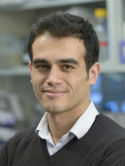Synthetic dual co-stimulation increases the potency of HIT and TCR-targeted cell therapies Journal Article
| Authors: | Dobrin, A.; Lindenbergh, P. L.; Shi, Y.; Perica, K.; Xie, H.; Jain, N.; Chow, A.; Wolchok, J. D.; Merghoub, T.; Sadelain, M.; Hamieh, M. |
| Article Title: | Synthetic dual co-stimulation increases the potency of HIT and TCR-targeted cell therapies |
| Abstract: | Chimeric antigen receptor T cells have dramatically improved the treatment of hematologic malignancies. T cell antigen receptor (TCR)-based cell therapies are yet to achieve comparable outcomes. Importantly, chimeric antigen receptors not only target selected antigens but also reprogram T cell functions through the co-stimulatory pathways that they engage upon antigen recognition. We show here that a fusion receptor comprising the CD80 ectodomain and the 4-1BB cytoplasmic domain, termed 80BB, acts as both a ligand and a receptor to engage the CD28 and 4-1BB pathways, thereby increasing the antitumor potency of human leukocyte antigen-independent TCR (HIT) receptor- or TCR-engineered T cells and tumor-infiltrating lymphocytes. Furthermore, 80BB serves as a switch receptor that provides agonistic 4-1BB co-stimulation upon its ligation by the inhibitory CTLA4 molecule. By combining multiple co-stimulatory features in a single antigen-agnostic synthetic receptor, 80BB is a promising tool to sustain CD3-dependent T cell responses in a wide range of targeted immunotherapies. © The Author(s), under exclusive licence to Springer Nature America, Inc. 2024. |
| Keywords: | controlled study; protein expression; unclassified drug; nonhuman; flow cytometry; cell proliferation; t lymphocyte; tumor associated leukocyte; lymphocytes, tumor-infiltrating; t-lymphocytes; mouse; animal; animals; mice; animal tissue; cell infiltration; tumor volume; clinical assessment; animal experiment; animal model; cell differentiation; antineoplastic activity; cytotoxicity; t lymphocyte receptor; immunology; lymphocyte activation; hematologic malignancy; immunotherapy; genetic engineering; cell culture; receptors, antigen, t-cell; western blotting; chimeric antigen receptor; cell therapy; electroporation; immunophenotyping; biological therapy; cytotoxic t lymphocyte antigen 4; cytokine release; fluorescence activated cell sorting; leukocyte antigen; adoptive immunotherapy; immunotherapy, adoptive; t lymphocyte activation; lymphocyte antigen receptor; cd28 antigen; b7 antigen; cancer transplantation; transcriptome sequencing; stimulation; tumor microenvironment; procedures; ctla-4 antigen; humans; human; male; female; article; cell- and tissue-based therapy; cell proliferation assay; tumor necrosis factor receptor superfamily member 9; receptors, chimeric antigen; nalm-6 cell line; cd28 antigens; crispr associated endonuclease cas9; b7-1 antigen; tumor necrosis factor receptor superfamily, member 9; human leukocyte antigen independent; synthetic dual co stimulation; t lymphocyte receptor targeted cell therapy |
| Journal Title: | Nature Cancer |
| Volume: | 5 |
| Issue: | 5 |
| ISSN: | 2662-1347 |
| Publisher: | Nature Research |
| Date Published: | 2024-05-01 |
| Start Page: | 760 |
| End Page: | 773 |
| Language: | English |
| DOI: | 10.1038/s43018-024-00744-x |
| PUBMED: | 38503896 |
| PROVIDER: | scopus |
| PMCID: | PMC11921049 |
| DOI/URL: | |
| Notes: | Article -- MSK Cancer Center Support Grant (P30 CA008748) acknowledged in PubMed and PDF (Currently misspelled as 'P30 CA08748') -- MSK corresponding author is Michel Sadelain -- Source: Scopus |
Altmetric
Citation Impact
BMJ Impact Analytics
Related MSK Work












